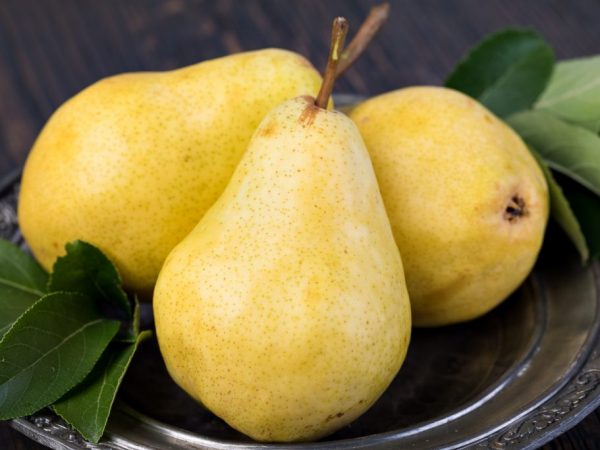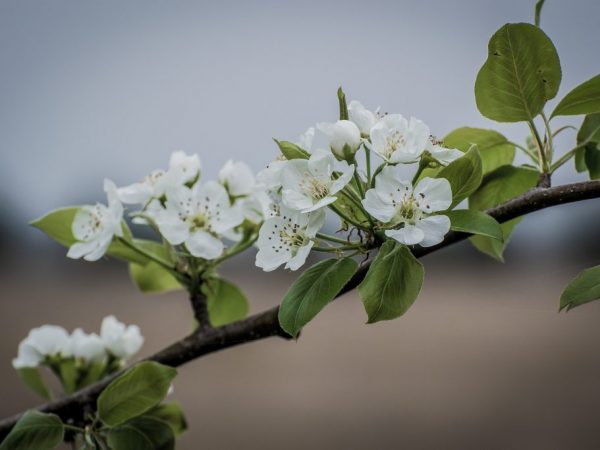Description of pear varieties Tavricheskaya
Pear fruits contain many vitamins. There are many varieties of this fruit, so it can be difficult to choose the right one. A bright and tasty representative is the Tavricheskaya pear.

Description of pear varieties Tavricheskaya
Characteristics of the variety
Tavricheskaya pear is an autumn variety. The tree is deciduous, flowering, has good frost and drought resistance. A characteristic feature of this variety is self-pollination and compatibility with quince. Trees do not freeze at temperatures between -28 ° C and 30 ° C. The variety is fast-growing. Fruiting occurs at 4 years on a quince rootstock and at 3 years on a pome rootstock. Flowering begins in early May. The yield is high, increasing every year.
Description of the tree
Deciduous tree, belongs to the flowering department.
It is distinguished by the following characteristics:
- height up to 3 m;
- pyramidal compact crown;
- dense foliage;
Description of fruits
Tavricheskaya pear fruits are characterized by removable ripeness in the last decade of September. Description of the appearance of the fruits and their properties:
- weight - 200-600 g;
- oval-conical, ovoid or wide-conical shape;
- bumpy surface;
- dense skin;
- bright yellow color;
- pink side.
The taste of ripe fruits is sweet and sour, pleasant. The pulp is juicy, soft cream. After ripening, the fruit sticks well to the branches, does not crumble.
Fruits are eaten fresh fresh or they are used for making preparations: jam, compotes or dried fruits are cooked. Pears can be transported without losing their presentation.
Growing pears
Choosing a planting site and seedling
Before planting on the site, the tree is determined the best place and a hole is prepared. Seedlings are chosen no older than 2 years. They take root well.
Particular attention is paid to the condition of the seedling. He should not have damage on the trunk, while he should have a well-developed root system.
Landing in the soil

A young tree needs to be fertilized
The best time for planting the Taurian pear is early spring or late autumn. This is due to the weak sap flow in the trunk and favorable weather conditions during this period (there is no frost on the soil).
A pit measuring 70 x 70 cm is dug 80 cm deep. Drainage is poured to the bottom. The pit is sprinkled with a small amount of soil mixture, a stake is inserted into the center, which serves as a support for the seedling.
For better growth of seedlings, soil preparation is carried out. Fertilizers are applied. To do this, mix the following components:
- compost - 10-12 kg (it is sometimes replaced with rotted manure);
- potassium salt - 50 g;
- superphosphate - 60 g.
The pit is watered with water, a seedling is placed next to the peg. All are sprinkled with soil mixture so that the root collar is 5-6 cm above the soil surface. The root zone is tamped, watered with water at room temperature: young seedlings of the Tauride pear do not like cold well water.
The peg is tied with a knot-eight to the seedling and mulching is carried out around the trunk. For this, manure or humus is used.Fertilizer should not touch the plant.
Plant care
In order for the seedlings to take root well, the soil should not be allowed to dry out. Watering is carried out once a week, 1 bucket of water is added under each tree. To prevent decay of the root system, if it rains too often, loosening is carried out from the root zone to the crown zone.
If the pear is planted in the northern regions, for the winter it is covered with burlap or spruce forest paws. In addition to heat, the spruce forest serves as protection against pests.
In the spring, all covering material is removed before the onset of heat, so that there is no overheating and steaming of the plant.
Fertilization
To obtain a good yield, pears are fertilized. For this, the soil is preliminarily loosened and a nutrient mixture is prepared with the following composition:
- 30 g of nitrate per 1 sq. m;
- 130 g of urea;
- 5 liters of water for each tree.
The solution is made in a proportion of 1 part of saltpeter and 50 parts of water. Watering the near-trunk circle. To enhance the effect, chicken manure and urea are added to the mixture.
Fruit trees do not like nitrogen, therefore, fertilizing with nitrogen-containing substances is carried out only in the first 2-3 years of their life. In the future, potash fertilizers are applied: once a year to the crown zone. At the end of May, 3 buckets of solution with nitroammophos (1: 200) are introduced under each tree.
To fertilize an adult plant, grooves are made in the peripheral crown zone. All trace elements and other top dressing are added to them.
Watering

The pear needs to be watered weekly
Any plant needs high-quality and timely watering. Tavricheskaya pear especially. The procedure is carried out weekly. With a lack of moisture, she sheds foliage, her fruits dry.
Watering is carried out in the crown zone, where the root system is located. The watering rate is 2-3 buckets for each year of life, taking into account the rainy season.
Diseases
Diseases arise from improper care or from bad weather. The Taurida variety is scab resistant, does not suffer from sunburn.
Powdery mildew appears in case of untimely spraying. It manifests itself as a whitish bloom and is a fungal disease. If you do not treat the affected areas, it will take over the entire tree.
Stem rot occurs after severe burns or poor nutrition. For prevention, timely fertilization is carried out.
Pest control
Pear pests include:
- pear honeydew;
- pear moth;
- gall midge;
- pest bug;
- tick.
To avoid the consequences and maintain productivity, when pests appear, they are treated with colloidal sulfur or insecticides.
Prophylaxis
It is easier to prevent diseases than to deal with them and their consequences. For this, spring and autumn pruning, pre-winter preparation and preventive spraying are carried out.
All affected areas are removed and burned. Prevent infection from entering compost pits.
Conclusion
It is not difficult to grow aromatic and tasty pears in the garden if you follow the simple growing rules.


